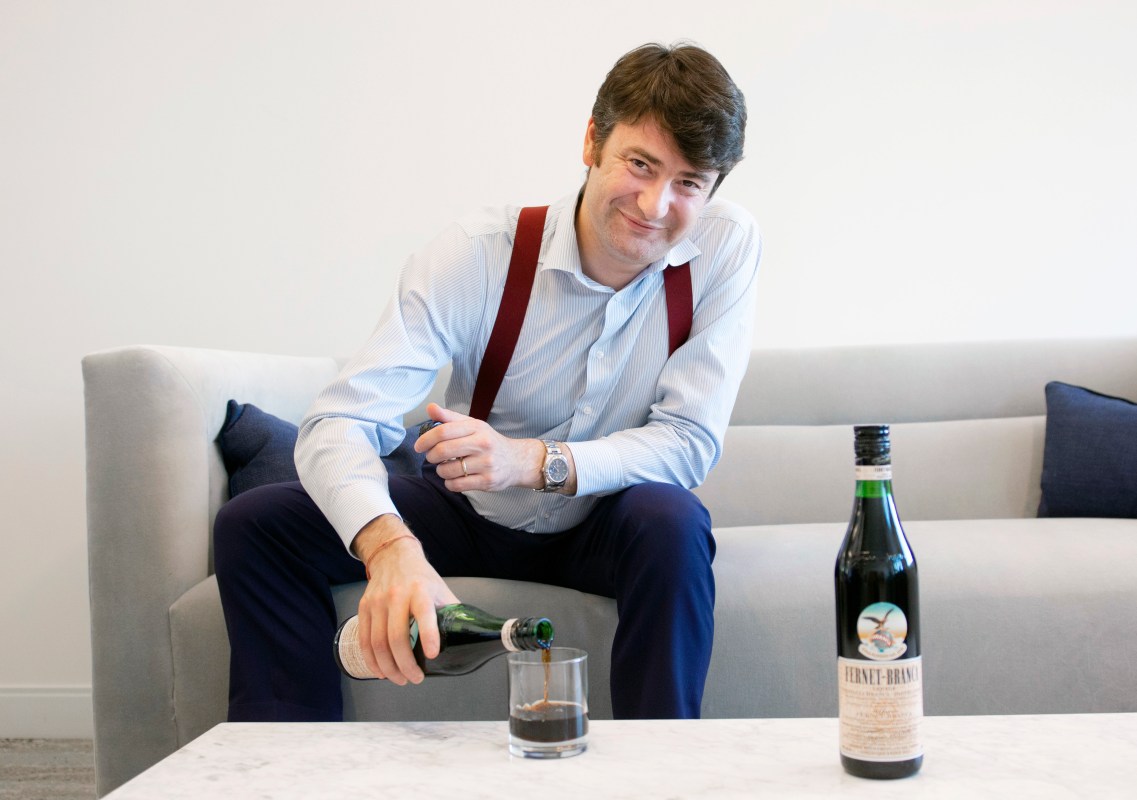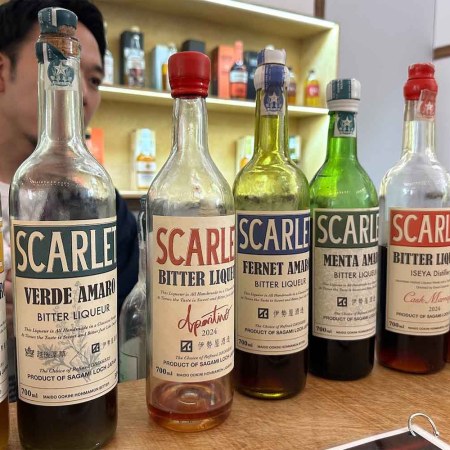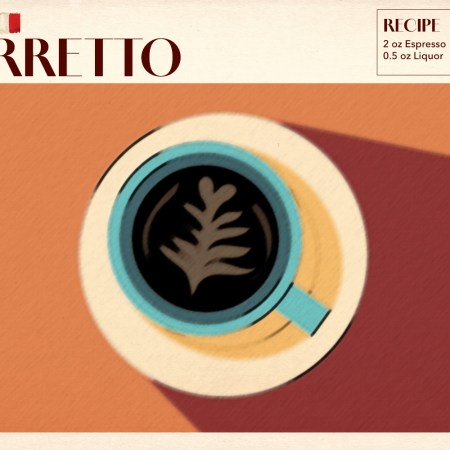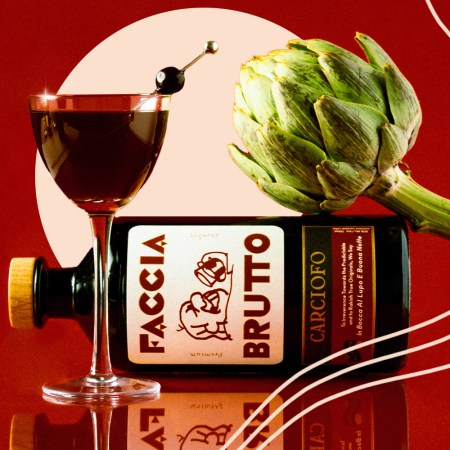Of the many boldfaced Italian surnames gracing the labels of amaro bottles, there may be none as iconic as Branca. Made in Milan since 1845, Fernet-Branca has become the most recognizable example of fernet, a sub-category of amaro that is loosely defined by its elevated level of alcohol, pronounced bitterness, black-licorice color and several common key ingredients, including saffron, chamomile, aloe ferox, myrrh and mint.
According to Edoardo Branca, who represents the sixth generation of the Branca family, the first records of sale for Fernet-Branca in the United States were in San Francisco in the late 1800s. By the early 2000s, the San Francisco bartending community had adopted Fernet-Branca as their preferred shift drink, typically served alongside a ginger ale or ginger beer back. This traveled beyond the Bay Area, and a shot of Fernet-Branca soon became a popular version of the “bartender’s handshake,” the spirited tradition of a gratis pour offered to a fellow bartender when they enter and pull up a stool or before they leave.
But generations before amaro became a popular post-prandial digestivo and featured as a key ingredient on craft cocktail menus around the world, these bittersweet, herbal liqueurs were consumed for medicinal purposes, typically related to digestion. Fernet-Branca was sold in pharmacies in Italy through the 1930s and was used in hospitals as an anti-choleric to help dehydrated patients regain their appetite. Fernet-Branca was sold as a cough syrup during the American Civil War and for years was produced and distributed from a factory located in what is now Tribeca in New York City as medicine during Prohibition. Having a presence in New York made business sense, since the city was a hub of commerce and transportation for the herbs and spices used to make Fernet-Branca. But after 9/11, Fratelli Branca shut down all operations; now the only production facility outside of their main operation in Milan is in Argentina, where Fernet-Branca has achieved a cult-like status, especially when mixed together with Coca-Cola, which travels by the name Fernet con cola.
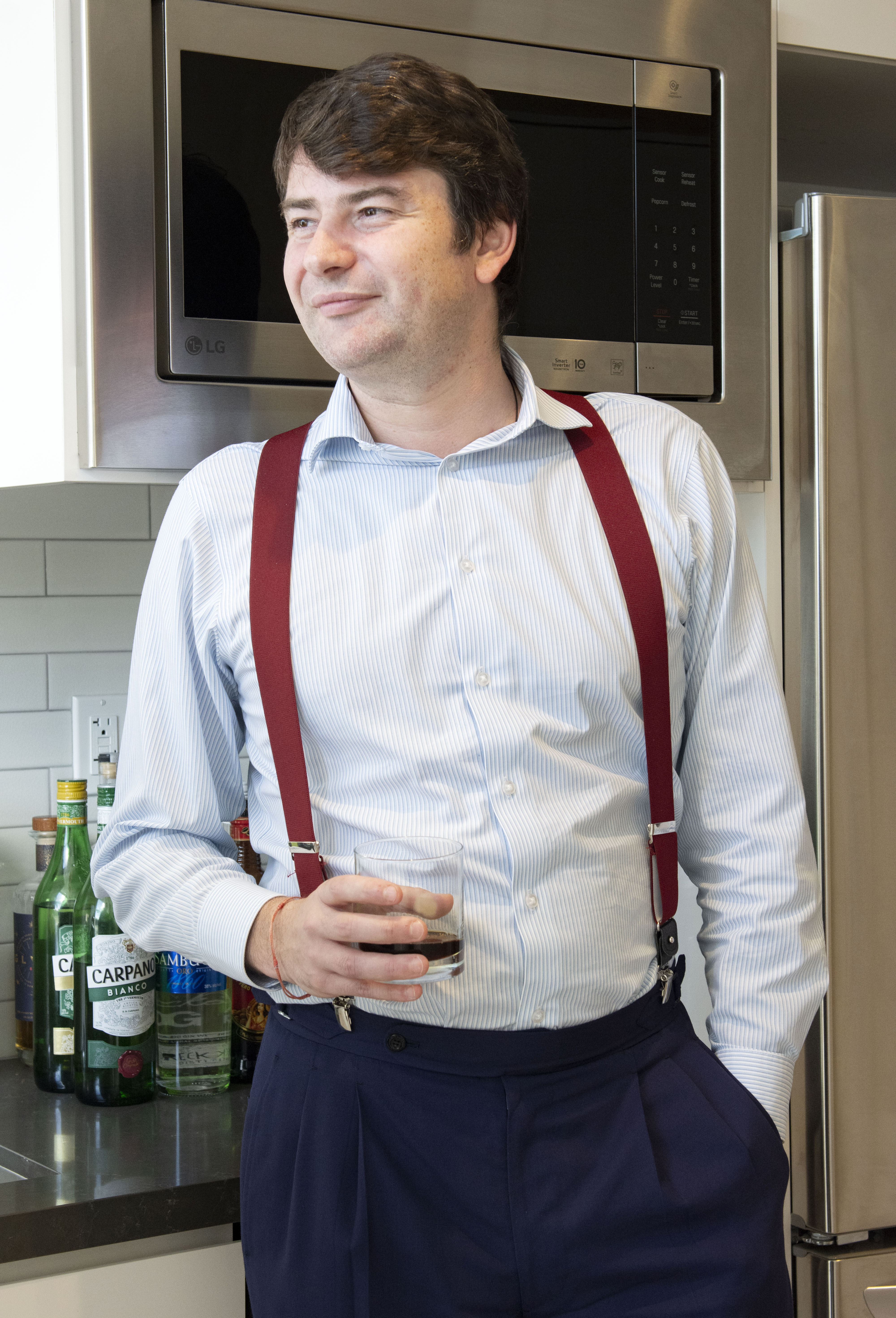
But 2019 marks a return to New York for Fernet-Branca. After years of working with importers to bring their portfolio (which includes Fernet-Branca, Brancamenta, Carpano Antica Formula, Punt e Mes, Stravecchio Branca, Sambuca and Caffè Borghetti) Stateside, they now act as their own importer and distributor as Branca USA — wholly owned subsidiary of Fratelli Branca — and recently opened their U.S. headquarters on the 42nd floor of the historic General Electric Building in Midtown Manhattan. “Last year when we decided on this big move, New York was our first choice,” Edoardo Branca tells InsideHook. “Having a company here where we had been established before felt like we had a history with the city.”
When I walked into the towering Art Deco lobby of the G.E. Building to meet with Branca, I had flashbacks of repeated viewings of Late Night with David Letterman, when Letterman was unceremoniously given the bum’s rush by building security (and memorably coined the phrase “the official G.E. corporate handshake” during repeated airings of the incident) when he filmed himself attempting to deliver a welcome fruit basket to G.E. after they acquired NBC in 1986.
My reception went much smoother, as the elevator doors opened to reveal the light-filled Branca USA offices with wraparound views of the late-afternoon Manhattan skyline. The team, led by C.E.O. Steve Brecher, had recently moved in and bubble-wrapped framed prints of vintage Fernet-Branca print ads leaned against the wall in strategic locations through the office, waiting to be hung on the clean white walls. A pair of Fernet-Branca-branded road bikes were parked on their kickstands just past reception. They did have their priorities, though, with a towering display of Fernet-Branca bottles of various sizes as well as a bar cart packed with bottles of Carpano Antica Formula. There’s a space earmarked for a soon-to-be added bar (a must-have for any spirits company), but until then, Branca leads me to the kitchen for a drink. Just as you might find in a typical Italian café, the amaro bottles are nestled together next to the espresso machine.
Branca takes two rocks glasses from the cupboard and pours us each two fingers of Fernet-Branca. Clinking our glasses together reminded me of the first time I met him in 2015, when he gave me a tour of the Branca museum and production facility in Milan while I was researching my book, Amaro. He had offered me a drink at their in-house bar before we parted ways. I asked him then to pour us each a Hard Start, a 50/50 shot of equal parts Fernet-Branca and Brancamenta, that was created by Brooklyn bartender Damon Boelte and has since traveled well beyond Kings County. Boelte, who rocks a tattoo interpretation of the Fernet-Branca eagle logo across his chest, is co-owner of Brooklyn bar Grand Army and recently joined Branca USA as Senior Portfolio Manager overseeing the Southern California region. Back then Edoardo shook his head at America’s mystification with shots, but after spending time in the States among so many bartenders, he admits he’s now on board with the tradition.
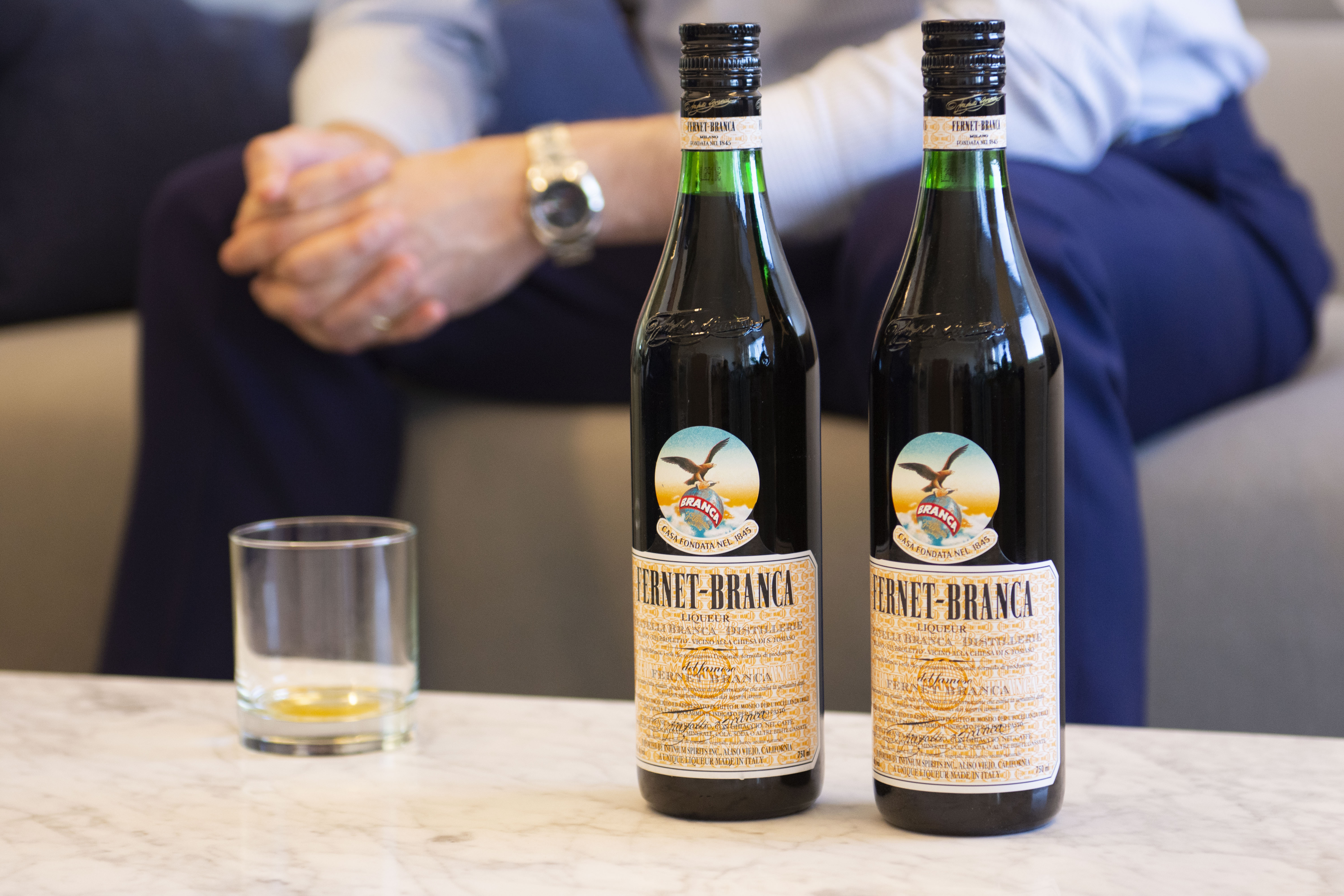
It might have seemed pre-ordained for Branca to join the family business, but the 36-year-old spent time as a banker (his pin-striped shirt and burgundy colored suspenders nod to his former profession) before his father Niccolò asked him to consider working with him. “I was a little bit shy, but my father is big personality,” recalls Branca. He started out in the finance department before becoming an Export Manager, overseeing markets in Australia, Japan, China, Albania, England and Africa. Branca then moved to America, settling in Orange County, California, for several years before briefly moving back to Milan for the birth of his daughter. He’s now back in New York in his new role as Managing Director of the company, and while he and his family have settled into a new apartment on the Upper West Side, he’s on the road three days a week, out in the field with Brecher conducting master classes and visiting accounts. “It’s important for me to stay connected with the bartending community who give so much love to us,” says Branca. “I want to try to give back to them and bring a little bit of insight about the brand. Sometimes it’s easy to stay closed in in the office looking at an Excel file and never going outside, but just walking the sidewalks of New York every day allows me to see trends happening all around me.”
While Branca is now the family’s face of the brand in the U.S., his father casts a large — and very distinguished — shadow representing Fernet-Branca around the globe. A couple of years ago I was at a conference in Milan with every major amaro producer in Italy represented. On the end of the last day, Count Niccolò Branca and his entourage walked the floor, and at each booth friends, colleagues and competitors greeted him with ceremony alike. Like many, I had read, heard and written that Edoardo Branca was a Count like his father, but he quickly set the record straight. “No, no, no. I am not a Count, and I’m happy not to be one, because I won’t become a Count until my father passes away,” he says. “It’s an inherited title. Normally it means you did a good deed, but what my father tells is it’s a title you need to continue to cultivate. You can’t live on a reputation of what you did, you need to continue to do good deeds.” Branca embarrassingly waved off any questions of being part of amaro royalty, but I wanted to know what it was like growing up Branca. He admits that there was a sense of having a well-known surname when he lived in Milan, but when his grandfather was alive he and his father rarely spoke about business at home. “My grandmother would tell me stories about the company and its history,” says Branca. “But it felt very normal.”
Branca did share some insights into Fernet-Branca’s secret recipe, recalling the day his father brought him into a room in the factory and broke down the formula, revealing the most important parts and production techniques. But his father then stopped, leaving out some key steps and details that will be revealed in time. “I know parts, but at the moment my father is the sole possessor of the whole recipe,” says Branca. “Where we keep the herbs at the factory there’s a small locked room and he goes in there every 15 days. When he’s in there, no one really knows what he’s doing.”
With his young daughter heralding the seventh generation of the Brancas, I wondered if he had any desire to see her follow his path. “Oh, I don’t know. I really don’t know,” says Branca. “Of course I would like to have her join the family business and give me a hand, like I’ve done with my own father. But at the same time I’m lucky enough that one day she might want to be an artist, like her mother, and take up painting. I want her to pursue her own happiness.”
Of all the references of Fernet-Branca in popular culture — from Fellini-directed television commercials to name-checks in hip-hop songs to The Sopranos — Branca’s favorite mention is from The Dark Knight Rises. A frustrated Michael Caine as Alfred Pennyworth confronts Bruce Wayne about imagining a life without Batman:
“Every year, I took a holiday. I went to Florence, there’s this cafe, on the banks of the Arno. Every fine evening, I’d sit there and order a Fernet-Branca. I had this fantasy, that I would look across the tables and I’d see you there, with a wife and maybe a couple of kids. You wouldn’t say anything to me, nor me to you. But we’d both know that you’d made it, that you were happy.”
The weekend the movie premiered in 2012, Branca received a text message from a friend asking him why he didn’t share that Fernet-Branca was The Dark Knight Rises. “I was like, we are not in Batman. We can not afford that kind of product placement,” recalls Branca. After Branca went to see it, the scene moved him, though he points out that unfortunately for people trying to recreate that moment in Florence, the bar doesn’t actually exist. “I have to tell you, too, that I’ve always loved Alfred as a character,” says Branca, twisting the cap off the bottle to top off our glasses. “He’s always supportive and is there to provide reason and advice and always providing vital information to Batman. To have such a person drinking Fernet in such a key scene — it was the perfect drink for the perfect person.”
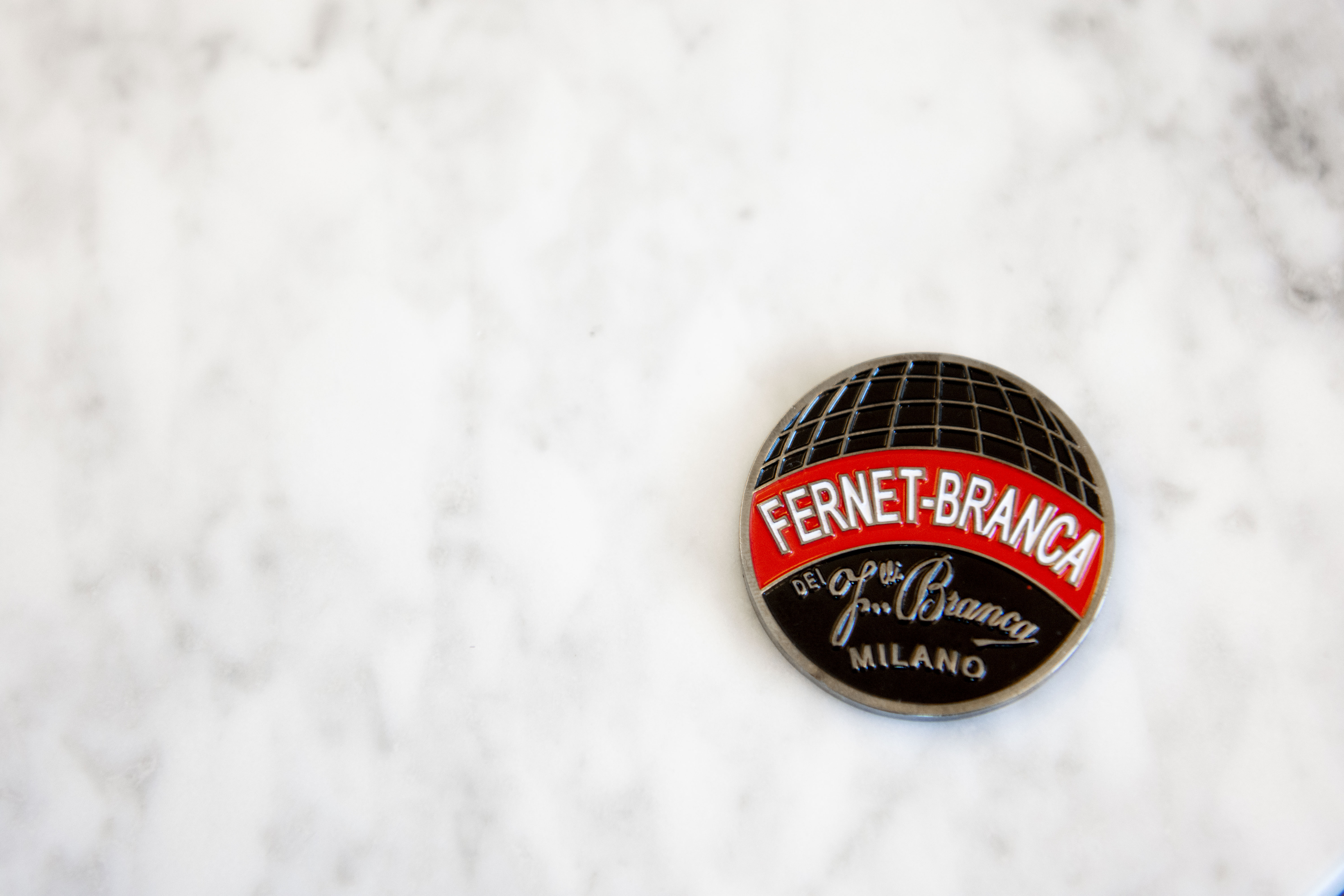
I take this moment to pull a Fernet challenge coin from my pocket and slap it on the table between us and ask him, “So how many times a week does this happen to you?” These hefty, silver dollar–sized coins are released in limited editions annually, and represent a key incentive and collectible for bartenders. Per tradition, the coin must be carried on you at all times; if you’re out drinking and you’re unable to produce your coin, or are the last person to do so, you’re responsible for buying the next round of Fernet-Branca shots. Branca recalls an event at Tales of the Cocktail in New Orleans, where he was giving away challenge coins to bartenders. Once the group gathered around him realized his last coin had been handed out, the challenges began one by one. “They had all their new coins and I had given away my last one. They knew what they were doing,” says Branca with a smile. “By the end of the night I was buying so many shots and I said, guys, you’re killing me. I exceeded my expense account limit for the week in one night.”
Next year will mark the 175th anniversary of Fernet-Branca, and while there will be a number of global events and surprises in store, Branca shares that a very collectible challenge coin will play a role in marking the occasion. “I can’t share the design with you just yet, but we’re going to print a special coin for the U.S. market limited to 175, each one numbered.” Any bartender lucky enough to add one to their collection won’t just be safe from getting stuck with the bar tab — they’ll also own a piece of one of the most enduring legacies in the world of spirits.
Every Thursday, our resident experts see to it that you’re up to date on the latest from the world of drinks. Trend reports, bottle reviews, cocktail recipes and more. Sign up for THE SPILL now.
